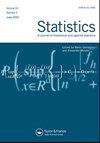具有分组变量的高维模型中惩罚非对称lq -范数的自动选择
IF 1.2
4区 数学
Q2 STATISTICS & PROBABILITY
引用次数: 0
摘要
研究了高维模型中蓝误差不对称情况下分组解释变量的自动选择问题。在引入模型和符号之后,我们定义了自适应群LASSO期望估计量,并证明了其稀疏性和渐近正态性。然后,通过考虑非对称lq -范数损失函数,推广了结果。在若干情况下,得到了关于变量群数目的理论结果。这个数字可以是固定的,也可以依赖于样本大小n,它可能与n具有相同的阶数。请注意,这些新的估计器允许我们考虑对数据和模型误差的较弱假设,而不是通常的假设。仿真研究表明,当样本量接近解释变量数量和模型误差不对称时,所提出的惩罚期望回归具有较好的竞争性能。考虑了空气污染数据的应用。本文章由计算机程序翻译,如有差异,请以英文原文为准。
Automatic selection by penalized asymmetric Lq-norm in a high-dimensional model with grouped variables
The paper focuses on the automatic selection of the grouped explanatory variables in a high-dimensional model, when the model blue error is asymmetric. After introducing the model and notations, we define the adaptive group LASSO expectile estimator for which we prove the oracle properties: the sparsity and the asymptotic normality. Afterwards, the results are generalized by considering the asymmetric Lq-norm loss function. The theoretical results are obtained in several cases with respect to the number of variable groups. This number can be fixed or dependent on the sample size n, with the possibility that it is of the same order as n. Note that these new estimators allow us to consider weaker assumptions on the data and on the model errors than the usual ones. Simulation study demonstrates the competitive performance of the proposed penalized expectile regression, especially when the samples size is close to the number of explanatory variables and model errors are asymmetrical. An application on air pollution data is considered.
求助全文
通过发布文献求助,成功后即可免费获取论文全文。
去求助
来源期刊

Statistics
数学-统计学与概率论
CiteScore
1.00
自引率
0.00%
发文量
59
审稿时长
12 months
期刊介绍:
Statistics publishes papers developing and analysing new methods for any active field of statistics, motivated by real-life problems. Papers submitted for consideration should provide interesting and novel contributions to statistical theory and its applications with rigorous mathematical results and proofs. Moreover, numerical simulations and application to real data sets can improve the quality of papers, and should be included where appropriate. Statistics does not publish papers which represent mere application of existing procedures to case studies, and papers are required to contain methodological or theoretical innovation. Topics of interest include, for example, nonparametric statistics, time series, analysis of topological or functional data. Furthermore the journal also welcomes submissions in the field of theoretical econometrics and its links to mathematical statistics.
 求助内容:
求助内容: 应助结果提醒方式:
应助结果提醒方式:


